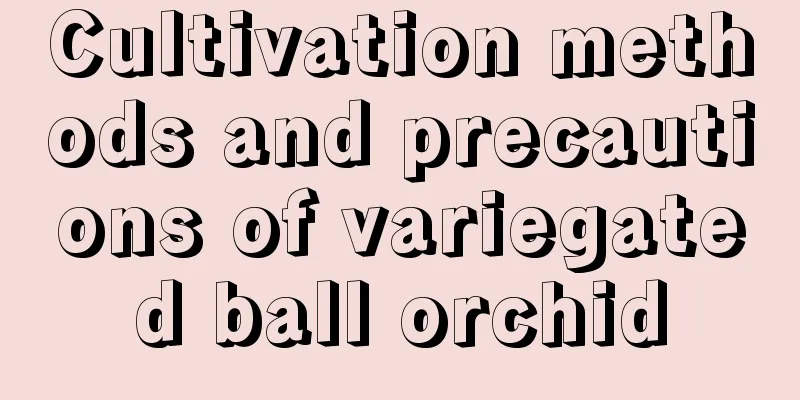Cultivation methods and precautions of variegated ball orchid

1. Maintenance methods1. Temperature: The most suitable temperature for its growth is 18-24℃. It likes a warm growing environment and can withstand a certain degree of high temperature. It can grow better at temperatures above 20℃. It is not cold-resistant, so pay attention to keep warm in winter. 2. Sunlight: It prefers a semi-shaded growing environment. Try not to let it be exposed to direct sunlight during daily cultivation. More than 3 hours of sunlight a day is enough, and it can be grown in the corner of the balcony. 3. Soil: It prefers loose, well-drained soil, preferably sandy soil. When preparing the soil, a mixture of garden soil and coarse sand is a good choice. In order to provide it with sufficient nutrients for growth, you can also add a small amount of leaf mold to the soil. 4. Water: From the moment it enters the growth period, you must provide it with sufficient water and try to keep the soil moist. Do not water it directly with tap water. It is best to dry it in the sun for two days. 2. Breeding techniques1. Reproduction: The simplest method is layering propagation. Layering propagation is to choose a relatively strong branch, and then press the part close to the top into the soil, keep the soil moist, and then cut it off for transplanting after it takes root. 2. Repotting: The variegated Hoya can be repotted all year round, but it is best to do it in the summer. The suitable temperature can allow it to adapt to the new growing environment more quickly. 3. Problem diagnosis and treatment1. Leaf spot disease: Leaf spot disease is prone to occur when the temperature is high, which provides convenient conditions for the breeding of many pathogens. When it is discovered, it is necessary to spray it with carbendazim in time. Persistent spraying will be effective. 2. Scale insects: Scale insects are pests that cause great harm to plants. When found, you can manually remove the insects. If you do not want to spray pesticides, you can cover the plants with gauze. IV. Other issues1. Is it poisonous? Many people think that the flower fragrance of the variegated Hoya is very strong and may be poisonous. In fact, it is not toxic at all. Not only that, it also has high medicinal value. 2. Can it be grown indoors: Variegated Hoya can be grown indoors. It does not require very much sunlight, so there is no problem in growing it indoors. It is also not toxic, so there is no danger in growing it normally. |
<<: Cultivation methods and precautions of white sandalwood cactus
>>: Brussels sprouts cultivation methods and precautions
Recommend
How to cultivate bonsai of cattail grass
1. Suitable soil If you want to cultivate a highl...
How to make sweet potatoes grow better (what fertilizer to use to grow sweet potatoes so that they are big and smooth)
Whenever we go to buy sweet potatoes, we will def...
When is the best time to sow the lily?
Time to sow the seeds of Violet The Violet Flower...
How to propagate peony by cuttings
Cutting method Preparation before cutting First, ...
Can gold diamonds be exposed to the sun? Are they afraid of the sun?
1. Whether you can get sun exposure It can bask i...
Cultivation methods and precautions of five-petal lotus
The five-petal lotus is also called yellow chrysa...
Cultivation methods and precautions of motherwort
1. Maintenance methods 1. Water management: Mothe...
Can poinsettia be hydroponically cultivated? Hydroponics cultivation methods and precautions
Can poinsettia be grown hydroponically? Poinsetti...
What is the name of the little orange?
1. Sugar orange The shape of the sugar mandarin o...
Tutorial on growing jackfruit seeds in pots
1. Select seeds Before planting in potted plants,...
Tomato cutting seedling raising technology, cutting propagation suitable time
1. Cutting time The time of cuttings should be de...
How to grow white orchid in autumn
1. How much water to use The amount of watering d...
Growth environment and growth characteristics of pine and cypress
Growth environment conditions of pine and cypress...
Common diseases of Ginkgo and their prevention and treatment
Common diseases of Ginkgo and their prevention an...
How to grow goldfish spider plants until they overflow the pot
1. Adequate sunlight If you want the goldfish pla...









